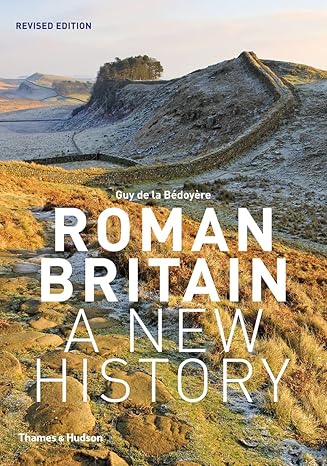Following on from my previous review of Echolands by Duncan MacKay on Boudica’s revolt against the Roman occupiers of Britain, this review is of Roman Britain: A New History by Guy de la Bédoyère. Roman Britain has a much wider scope than Echolands covering the whole period of Roman influence in Britain from Caesar’s abortive invasions in 55 and 54BC through to the period after the Roman’s left Britain in 410AD. This is a larger format book with illustrations and photographs on virtually every page.
The book starts with three chapters on the timeline of Roman Britain covering the pre-invasion period, the extended conquest and the later period. Eight chapters follow on different themes: governing Britain, military installations, towns in Roman Britain, industry, commerce and production, the countryside and villas, people and places of roman Britain, religion in Roman Britain and the aftermath.
Britain was know to the Greeks as far back as the 4th century BC, and there was trade in tin from Britain from that time. By the middle of the 2nd century BC ornate burials were being found in Britain containing imported goods, and coinage was starting to be found. Hengistbury Head, where my father lived in his retirement, was an important trade port in this period. This tells us that Britain was not unknown to the outside world when Caesar made his invasion attempts in 55BC and 54BC. These were unsuccessful in the immediate sense but over the intervening years to the invasion proper in 43AD there was a gradual Romanisation of the upper echelons of British society, and increased trade.
Both Caesar’s abortive invasion, and Claudius’s successful invasion in 43AD were driven by politics in Rome, military success were a credit to an Emperor. British politics may well have played a part: Cunobelinus, king of a large chunk of Britain, died in 43AD and the resulting uncertainty over succession was a good opportunity to invade. Claudius’s invasion succeeded because the Roman army were a very efficient, well-equipped military force and their opposition was divided with some on the British side likely supporting the Romans.
The Romans spread to a line linking Lincoln and Exeter by 47AD, and by the end of the 1st century they had reached the limits of Wales and the far North of Scotland. Over the next 50 years there was some consolidation but by 150AD the Roman’s had reached the geographic limit of their occupation of Britain. It seems that the South-East of Britain became fairly well Romanised with villas and towns in the Roman style. North and West of the 47AD frontier life seemed to continue more in the manner of the Iron Age but for the addition of Roman garrisons and forts with related trade and industries.
Most of what we know of Roman life in Britain is based on the inscriptions left by the military, on tombstones and dedications of building works. There are limited number of wooden writing tablets, discovered at Vindolanda by Hadrian’s Wall and in London, which provide a fascinating insight into daily life, trade and interpersonal relationships. The early period of the occupation is discussed in Tacitus’s writings, as well as some other fragments.
We get a very small sample of daily life from from archaeology, only about 0.01% of all deaths are represented in burials and, assuming villas had 40 occupants each, homes for only about 0.01% are known.
Much of the rest of our understanding seems to come from recognising that Britain was being run like any other Roman province and extrapolating across archaeological and historical writings from all over the empire. Roman’s had firm ideas about which people could hold which positions (qualified by property), and Roman towns had a specific set of amenities according to their official type. Britain was seen as a troublesome province and had quite senior governors who typically only had a short tenure – some went on to become Emperor.
The Roman’s seemed to have respected the British as traders, seeing them as taking on Roman ways in this regard. Agriculture was important, and there is a lot of evidence of lead production – unlike iron, lead tends to survive quite well. Coinage was only minted in Britain from the late third century – it would not be used so heavily until the 17th.
There is limited evidence for the health and ethnicity of the Roman Britons, they seem to have increased dental issues. There was certainly the idea of branded medications, particularly for eye conditions. It isn’t clear whether there was a patent system. It is certain that Roman soldiers came from around the Empire but identifying them is hard since typically they Romanised their names.
Most of the writing we find the Roman period relates to religion (shrines, tombstones, altars). For a large part of the Roman period people worshipped hybrid Gods – amalgams of Roman Gods with local pagan deities or even from elsewhere in the Roman empire. Later the Christian church became established – we have written evidence of a church hierarchy from 314AD.
From the beginning of the third century AD the Roman empire was beginning to split up. Rome finally withdrew support for the military occupation of Britain in 410AD. This had an immediate economic impact because there was no longer new coinage coming into the country, or military salaries to spend. Physically Roman buildings decayed over a period of 150 years or so with the now non-Roman occupants no longer having the will or skill to repair them. We can mark the complete end of practical Roman influence with the invasion of the Anglo-Saxons in 577AD although we see the marks of the Roman occupation even now in our landscape and language.
Roman Britain finishes with a chronology and a guide to visiting Roman sites in Britain, I feel in this section insufficient attention is paid to my home town of Chester!
This is a beautiful book, and rather readable.


